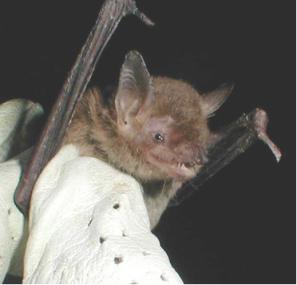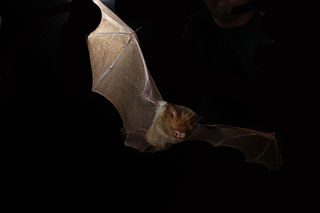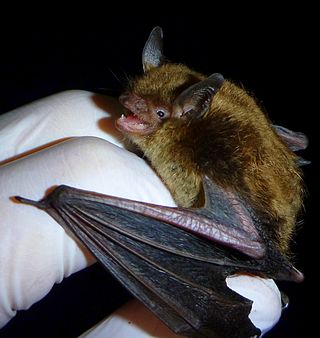
The greater bulldog bat or fisherman bat is a species of fishing bat native to Latin America. The bat uses echolocation to detect water ripples made by the fish upon which it preys, then uses the pouch between its legs to scoop the fish up and its sharp claws to catch and cling to it. It is not to be confused with the lesser bulldog bat, which, though belonging to the same genus, merely catches water insects, such as water striders and water beetles.

Natterer's bat is a European vespertilionid bat with pale wings. It has brown fur tending to greyish-white on its underside. It is found across most of the continent of Europe, parts of the Near East and North Africa. It feeds on insects and other invertebrates which it catches on the wing or pursues on the ground.

The lesser horseshoe bat is a type of small European and North African insectivorous bat, related to its larger cousin, the greater horseshoe bat. As with all horseshoe bats, the species gets its name from its distinctive horseshoe-shaped noseleaf.

The brown long-eared bat or common long-eared bat is a small Eurasian insectivorous bat. It has distinctive ears, long and with a distinctive fold. It is extremely similar to the much rarer grey long-eared bat which was only validated as a distinct species in the 1960s. An adult brown long-eared bat has a body length of 4.5–4.8 cm, a tail of 4.1–4.6 cm, and a forearm length of 4–4.2 cm. The ears are 3.3–3.9 cm in length, and readily distinguish the long-eared bats from most other bat species. They are relatively slow flyers compared to other bat species.

The greater noctule bat is a rare carnivorous bat found in Europe, West Asia, and North Africa. It is the largest and least studied bat in Europe with a wingspan of up to 46 centimetres (18 in) and is one of the few bat species to feed on passerine birds. Greater noctule bats are the only bat species to hunt birds on the wing rather than when roosting. The greater noctule bat has wings adapted for open-air hunting and uses echolocation frequencies above the hearing range of birds.

The silver-tipped myotis is a species of mouse-eared bat found in a range of lowland habitats in the Americas.

The common noctule is a species of insectivorous bat common throughout Europe, Asia, and North Africa.

Nyctophilus geoffroyi is a vespertilionid bat. a flying nocturnal mammal found in Australia, The species is relatively common. They have been referred to as the lesser long-eared bat.

The south-eastern long-eared bat or Corben's long-eared bat, is a species of bat found in Australia. It occurs in the woodlands of the Murray Darling Basin and adjacent areas.

Bechstein's bat is a species of vesper bat found in Europe and western Asia, living in extensive areas of woodland.

Brandt's bat or Brandt's myotis is a species of vesper bat in the family Vespertilionidae. It is native throughout most of Europe and parts of western Asia.

The long-eared myotis is a species of vesper bat in the suborder Microchiroptera. It can be found in western Canada, the western United States, and Baja California in Mexico.

The cave myotis is a species of vesper bat (Vespertilionidae) in the genus Myotis.

The Yuma myotis is a species of vesper bat native to western North America.

The diadem leaf-nosed bat or diadem roundleaf bat is one of the most widespread species of bat in the family Hipposideridae. It is probably most closely related to Hipposideros demissus from Makira and to Hipposideros inornatus from the Northern Territory in Australia. Hipposideros diadema is found in Australia, Indonesia, Malaysia, Myanmar, the Philippines, Thailand, and Vietnam.

Mehely's horseshoe bat is a species of insectivorous bat in the family Rhinolophidae found in Southern Europe and parts of the Middle East. It is distributed in a narrow band around the Mediterranean Sea from North-Western Africa across Portugal, Spain, the Balearics, southern France, Sardinia, Sicily and the Balkan Peninsula to Asia Minor.

The little brown bat or little brown myotis is an endangered species of mouse-eared microbat found in North America. It has a small body size and glossy brown fur. It is similar in appearance to several other mouse-eared bats, including the Indiana bat, northern long-eared bat, and Arizona myotis, to which it is closely related. Despite its name, the little brown bat is not closely related to the big brown bat, which belongs to a different genus.

Myotis septentrionalis, known as the northern long-eared bat or northern myotis, is a species of bat native to North America. There are no recognized subspecies. The northern long-eared bat is about 3–3.7 inches in length, with a wingspan of 9–10 inches. It is distinguishable by its long ears when comparing it to other bats in its genus. This species is commonly found in the northern United States and Southern Canada east of British Columbia. The geographic range includes 37 states.

The long-fingered bat is a carnivorous species of vesper bat. It is native to coastal areas around the Mediterranean Sea, as well as a few patches of land in western Iran. Due to the fact that its population is in decline, it has been listed as Vulnerable on the IUCN Red List since 1988.

Daubenton's bat or Daubenton's myotis is a Eurasian bat with rather short ears. It ranges from Ireland to Japan (Hokkaido) and is considered to be increasing its numbers in many areas.























